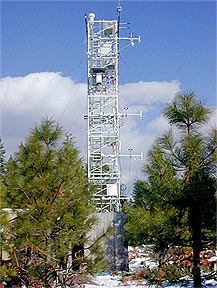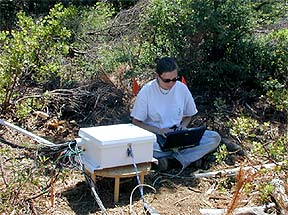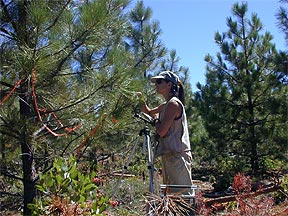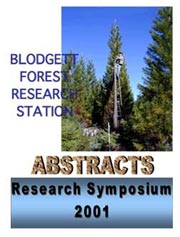We measure canopy scale fluxes of alcohols (2-methyl-3-buten-2-ol (MBO), methanol, and ethanol) above a ponderosa pine plantation near Blodgett Forest Research station since summer 1999. Emissions show diurnal cycles with maximum fluxes around noon. Mean daytime MBO and methanol emissions were ~1.3 mg C m-2 h-1, ethanol emissions were five times lower. Both methanol and ethanol daytime emissions appear to be influenced by stomatal opening as suggested from correlations between the measured fluxes and light, vapor pressure deficit, and ozone deposition. In addition, ethanol fluxes decreased with soil moisture in 1999, suggesting a possible influence of anaerobic production in the tree's roots. This may explain high ethanol mixing ratios in the air above the plantation during the rainy season. MBO fluxes were compared to a detailed leaf level emission model, showing that the tree's emission potential dropped after a frontal passage with low air temperatures, and then recovered after the onset of warmer temperatures. The origin and function of that alcohol within the plant is the same than for isoprene in oak trees. The origin and function of the alcohols methanol, and ethanol in plants is currently under investigation. Our data suggests that ponderosa pine resorts to ethanolic fermentation as a more robust, though inefficient way to produce energy when it is under (ozone or draught) stress.
ATMOSPHERIC TESTING:
Under the direction of Dr. Allen Goldstein, a research site to assess factors controlling ozone deposition to the forest and to study forest response was established in 1997 in a Sierra Pacific Industries owned ponderosa pine plantation immediately adjacent to Blodgett Forest.
A 70-foot tower was erected with multiple monitoring devices attached, operated by an electrical generating system. A temperature controlled instrument building and generator shed have been added.
This site has expanded to year-round operation, with multi-disciplinary research and numerous researchers establishing projects, making this one of the most active individual research sites on Blodgett Forest.
|
 |
Meredith Kurpius operating the first down of sap velocity measurements.
 |
Jeanne Panek taking tree physiological measurements.
 |
|
Contact Author: Gunnar W. Schade, University of California, Berkeley, Department of Environmental Science, Policy, and Management, Ecosystem Science Division, 151 Hilgard Hall, Berkeley, CA 94720-3110, (510) 643-6449, gws@nature.berkeley.edu
|




